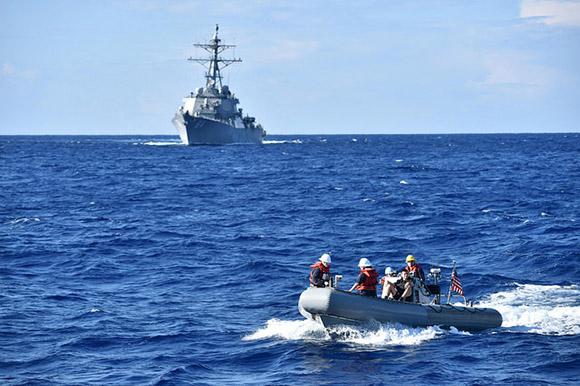The Pentagon would be evaluating the permanent redeployment of a naval force in the Mediterranean to cope with the migrant crisis and in response to greater Russian naval capabilities. This is what transpires from Moscow, according to rumors obtained from official US Navy sources.
"The continued use and redeployment of the four missile destroyers stationed in Rota, Spain, has changed the Pentagon's initial strategy. The new context in the Region requires long-term redevelopment on specific missions".
The destroyers should have played a crucial role in the Ballistic Missile Defense in Europe: a task they may never perform. He would have added the US Navy official to the Sputnik agency: "It could be said that due to the problem of migrants and the greater presence and capacity of Russian ships, a permanent naval presence in the Mediterranean is being evaluated". These preliminary discussions would already be underway.
Among the countries involved, Spain and Italy are at the top of the list. The latter would guarantee the best option to support a new fleet. Sicily, we recall, guarantees with Sigonella the logistic base in support of all the operations of the US Navy's Sixth Fleet in the Mediterranean. The United States has not had a continuous presence in the Mediterranean Sea since the mid-90s, after the end of the Cold War.
The Russians, by contrast, since the first of May of the 2013, have grouped all the warships in the Mediterranean into a single task force. Before the annexation of Crimea, the Mediterranean war fleet was composed of eleven ships. The flagship of the Fleet (we are talking about the official redevelopment that does not take into account the shifts in the units participating in the campaign in Syria) is the missile cruiser 'Slava', the carrier-killer 'Moskva'. The battle group is formed by the 'Udaloy' class destroyer, the 'Admiral Panteleyev', and the missile destroyers 'Kashin-Mod', the 'Neustrashimy' and the 'Smetlivy'.
 The amphibious assault force is composed of the large 'Alligator' class landing ships, the 'Alexander Shabalin' (photo on the right), the 'Novocherkassk', the 'Nikolai Filchenkov' and the 'Minsk'. The amphibious assault ship 'Ropucha', the 'Yamal', also joined from the Black Sea Fleet. The Russian Navy has annexed two corvettes, a command ship, several missile cruisers, minesweepers and the submarine from the Ukrainian Navy Zaporizhia for a total of 54 boats, many of them however in very bad conditions. Discounted the presence of two nuclear-powered class 'Akula' attack submarines. Russia has increased its naval presence in the Mediterranean after announcing 2012 in December, the creation of a permanent war fleet to protect its interests in the region.
The amphibious assault force is composed of the large 'Alligator' class landing ships, the 'Alexander Shabalin' (photo on the right), the 'Novocherkassk', the 'Nikolai Filchenkov' and the 'Minsk'. The amphibious assault ship 'Ropucha', the 'Yamal', also joined from the Black Sea Fleet. The Russian Navy has annexed two corvettes, a command ship, several missile cruisers, minesweepers and the submarine from the Ukrainian Navy Zaporizhia for a total of 54 boats, many of them however in very bad conditions. Discounted the presence of two nuclear-powered class 'Akula' attack submarines. Russia has increased its naval presence in the Mediterranean after announcing 2012 in December, the creation of a permanent war fleet to protect its interests in the region.
In its most recent maritime strategy doctrine, Russia has declared its commitment to maintaining a presence in the Black Sea, the Mediterranean and the Arctic.
(photo: US DoD / MoD Russian Fed.)












